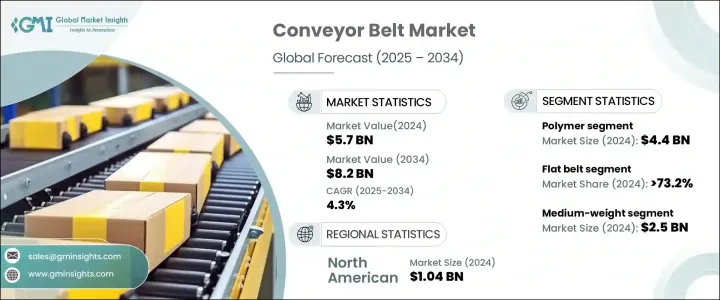
세계 컨베이어 벨트 시장은 2024년에 57억 달러로 평가되었고, 2025-2034년 연평균 4.3% 성장할 것으로 예상됩니다.
이러한 성장의 원동력은 광업, 철강 생산, 시멘트 제조, 식품 가공 등 다양한 분야의 산업 활동 증가입니다. 산업계가 업무 효율을 최적화하고 생산성을 높이기 위해 노력하는 가운데, 컨베이어 벨트는 자재 취급, 특히 무거운 물체의 원활한 운송이 필요한 수요가 많은 분야에서 필수적인 요소로 자리 잡고 있습니다.

컨베이어 벨트에 대한 수요는 원자재 및 천연 자원에 대한 수요 증가로 인해 증가하고 있으며, 광업 및 건설과 같은 산업은 효율성과 안전성을 위해 이러한 시스템에 크게 의존하고 있습니다. 광업 분야에서 컨베이어 벨트는 광석, 석탄 및 기타 재료를 광산 현장에서 처리 장비로 운반하여 작업을 간소화하여 수작업과 작업 비용을 크게 줄입니다. 철강 제조업체는 컨베이어 벨트를 사용하여 고온 용광로로의 운송을 포함하여 다양한 생산 단계를 통해 무거운 원료를 이동시킵니다. 또한, 시멘트 제조 및 식품 가공과 같은 산업은 컨베이어 시스템을 통해 연속적이고 통제된 원료의 흐름을 가능하게 하여 전반적인 생산성을 높이고 다운타임을 줄여주는 혜택을 누리고 있습니다. 스마트 센서 및 자동 모니터링 시스템과 같은 컨베이어 벨트 기술의 발전은 산업 환경에서 내구성, 효율성 및 안전성을 향상시킴으로써 시장 성장에 더욱 기여하고 있습니다.
| 시장 범위 | |
|---|---|
| 시작 연도 | 2024년 |
| 예측 연도 | 2025-2034년 |
| 시작 금액 | 57억 달러 |
| 예상 금액 | 82억 달러 |
| CAGR | 4.3% |
이 시장은 금속, 폴리머, 폴리머, 나일론, 폴리에스테르, 기타 등 소재 유형에 따라 세분화됩니다. 고무, PVC, 폴리우레탄, 폴리우레탄, 열가소성 엘라스토머로 구성된 폴리머 부문은 2024년 44억 달러의 매출로 시장을 장악하고 예측 기간 동안 4.5%의 연평균 복합 성장률(CAGR)을 나타낼 것으로 예측됩니다. 폴리머 컨베이어 벨트는 뛰어난 강도, 유연성, 내마모성으로 인해 널리 선호되고 있습니다. 광업, 건설, 물류 및 기타 산업은 마모 환경을 견디고 장기적인 성능을 보장하기 위해 폴리머 기반 벨트에 크게 의존하고 있습니다. 특히 고무 컨베이어 벨트는 내구성이 뛰어나 고하중 및 가혹한 조건에서 작업하기에 적합합니다.
시장은 또한 평벨트, 모듈형 벨트, 클리트 벨트 등 제품 유형별로 분류되며, 2024년 기준 평벨트가 전체의 73.2%를 차지하며 시장을 주도하고 있으며, 2034년까지 4.3%의 연평균 복합 성장률(CAGR)로 견조한 성장세를 보일 것으로 예상됩니다. 평벨트는 범용성이 높아 포장, 제조, 식품 가공, 물류 등의 산업 분야에서 사용하기에 적합합니다. 최대 16°까지 경사 이송이 가능하고 다양한 재료를 이송할 수 있어 다양한 분야에서 폭넓게 채택되고 있습니다.
북미는 전 세계 컨베이어 벨트 시장의 34%를 차지하며 2024년 매출액이 10억 4,000만 달러로 가장 큰 비중을 차지할 것으로 예상됩니다. 이 지역 시장 확대는 주로 자동차 및 제조업과 같은 주요 산업에서 컨베이어 시스템 채택이 확대되고 있기 때문입니다. 북미 전역의 기업들은 생산성 향상, 운영 비용 절감, 작업장 안전 향상을 위해 첨단 컨베이어 기술을 도입하는 경향이 증가하고 있습니다. 주요 제조업체의 존재와 컨베이어 벨트 소재 및 스마트 자동화 솔루션의 지속적인 기술 혁신은 시장을 더욱 발전시키고 있습니다. 산업계가 효율성과 지속가능성을 최우선 과제로 삼고 있는 가운데, 기술적으로 진보된 컨베이어 벨트에 대한 수요는 향후 몇 년 동안 지속적으로 증가할 것으로 예상됩니다.
The Global Conveyor Belt Market was valued at USD 5.7 billion in 2024 and is projected to grow at a CAGR of 4.3% between 2025 and 2034. This growth is driven by increasing industrial activities across various sectors, including mining, steel production, cement manufacturing, and food processing. As industries strive to optimize operational efficiency and enhance productivity, conveyor belts have become indispensable in material handling, particularly in high-demand sectors requiring seamless transportation of heavy materials.

The demand for conveyor belts is fueled by the rising need for raw materials and natural resources, with industries such as mining and construction relying heavily on these systems for efficiency and safety. In the mining sector, conveyor belts streamline operations by transporting ores, coal, and other materials from extraction sites to processing units, significantly reducing manual labor and operational costs. Steel manufacturers utilize conveyor belts to move heavy raw materials through various production stages, including transportation to high-temperature furnaces. Additionally, industries like cement manufacturing and food processing benefit from conveyor systems that enable continuous and controlled material flow, enhancing overall productivity and reducing downtime. The ongoing advancements in conveyor belt technology, including smart sensors and automated monitoring systems, further contribute to market growth by improving durability, efficiency, and safety in industrial settings.
| Market Scope | |
|---|---|
| Start Year | 2024 |
| Forecast Year | 2025-2034 |
| Start Value | $5.7 Billion |
| Forecast Value | $8.2 Billion |
| CAGR | 4.3% |
The market is segmented based on material types, including metal, polymer, nylon, polyester, and others. The polymer segment, which comprises rubber, PVC, polyurethane, and thermoplastic elastomers, dominated the market with USD 4.4 billion in revenue in 2024 and is expected to grow at a CAGR of 4.5% during the forecast period. Polymer conveyor belts are widely preferred for their exceptional strength, flexibility, and resistance to wear and tear. Industries such as mining, construction, and logistics heavily depend on polymer-based belts to withstand abrasive environments and ensure long-term performance. Rubber conveyor belts, in particular, offer superior durability, making them the go-to choice for operations involving heavy loads and harsh conditions.
The market is also categorized by product types, including flat belts, modular belts, and cleated belts. The flat belt segment led the market, accounting for 73.2% of the total share in 2024, and is projected to maintain a steady CAGR of 4.3% through 2034. Flat conveyor belts are highly versatile, making them ideal for applications across industries such as packaging, manufacturing, food processing, and logistics. Their ability to transport a diverse range of materials while accommodating inclined transportation up to 16° has led to widespread adoption across multiple sectors.
North America held a significant share of the global conveyor belt market, accounting for 34%, with USD 1.04 billion in revenue in 2024. The region's market expansion is primarily attributed to the growing adoption of conveyor systems in key industries such as automotive and manufacturing. Companies across North America are increasingly implementing advanced conveyor technologies to enhance productivity, reduce operational costs, and improve workplace safety. The presence of major manufacturers, along with continuous innovations in conveyor belt materials and smart automation solutions, further propels the market forward. As industries continue to prioritize efficiency and sustainability, the demand for technologically advanced conveyor belts is expected to witness sustained growth over the coming years.